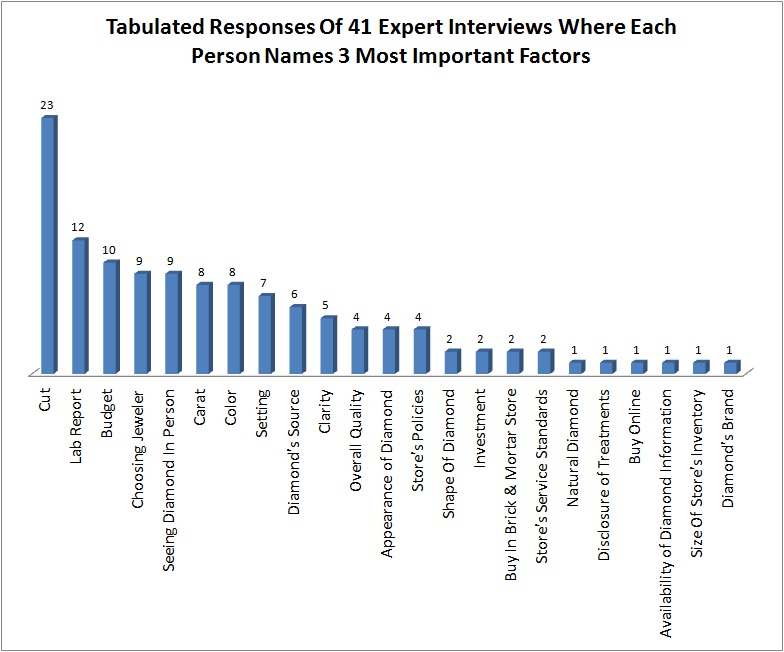41 Industry Experts Reveal Factors On How They Choose And Buy Diamonds For Themselves
For many diamond shoppers, buying a diamond ring can be one of the most confusing and intimidating experience as a consumer. Why is that so? Well, diamonds are expensive purchases and involve careful consideration of various factors like budget, setting design and the 4Cs (just to name a few).
Almost every day, I get emails from consumers seeking help and advice on their purchase. The majority of the questions usually revolve around the 4Cs and a second opinion about their diamond choices. And then it got me thinking…
Will someone with gemological knowledge or experience in the diamond business make their buying choices differently from the general public?
The Tables Have Turned This Time
Wouldn’t you like to know how the experts shopped for their diamonds? What might they do if they were in your shoes as a consumer? Would they utilize some special tools to make their selections or do they have some secret insights you didn’t know about.
That’s what I set out to discover.
And guess what? Some of their replies might come as a surprise to you.
Most Important Factors For a Purchase
(interview of 41 experts)
#1: Cut – 23 experts (56%)
#2: Lab Report – 12 experts (29%)
#3: Budget – 10 experts (24%)
#4: Jeweler Choice & Seeing Diamond in Person – Tied at 9 experts (22%)
#5: Carat & Color – Tied at 8 experts (20%)
To view more details of the results and how the study was performed, click here…
Each of the 40 experts has to list 3 most important factors of buying a diamond. If they listed more than 3 in their response, only the first 3 factors are taken into account.
Derivation of the figures above: Number of times mentioned / Total number of interviewees * 100%
e.g. Cut was mentioned 23 times. 23/41 * 100 = 56%
Who Are The Industry Experts?
Here are my criteria for selecting people for the interview. In order to be classified as an expert, the person would have to fall under one or more of the following categories:
1) Must have undergone proper gemological training.
2) Own or work in a diamond jewelry business (online or offline is fine).
3) Have at least 1-2 years of hands-on experience in dealing with diamonds.
Outreach Program to Interview Experts
A few weeks ago, I started emailing professionals in the industry with the following question:
“Imagine yourself as a consumer. If you were shopping for a diamond for yourself, what are the 3 most important factors that would affect your choice and why?
e.g. seeing diamond in person, color, online store, friend’s recommendation, grading reports, carat size, cut, vendor’s policy, setting design, budget etc… or any other factors (there’s no right or wrong opinions here).”
* I used a program to randomize the order of the listed factors and their appearances in each email to lower the possibility of instilling bias from the question.
For a review of the compiled responses, click here...
Cut is the by far the biggest factor and more half of the experts list it as one of their top 3 factors when choosing a diamond. If you think about it, cut has the largest impact of the sparkle and brilliance of the diamond. It’s easy to understand why it topped the chart. After all, who wouldn’t want a beautiful looking diamond?
The next factor (#2) might raise some eyebrows. Approximately 30% of the experts stated the need for a reliable lab report. Yes, you heard that right; and I know what you are probably thinking about now.
Why would an expert require a lab report when buying a diamond? Don’t they already have the necessary skillsets and experience to determine a diamond’s quality themselves?
Well, for starters, let me tell you that it isn’t that easy to grade a diamond without the necessary conditions in place. For example, trying to precisely grade an F color from a G color mounted diamond under a jewelry store’s lighting would be immensely difficult even to someone with years of experience.
On top of that, detecting synthetics and treated diamonds may not be straightforward without proper lab testing equipment. That’s why a reliable 3rd party grading report (e.g. from GIA) will offer assurance that you are getting a diamond of the described quality.
In comparison, based on my experience with consumers, there are many people who don’t really understand the need for a reliable grading report. The takeaway here is: if the experts themselves are demanding a grading report for their purchase, doesn’t that speak volumes about its importance?
Lastly, if you take a look at the full list of responses, it appears that the experts make their choices based on similar concerns a typical consumer has! Isn’t that amazing to know that they aren’t that different from you or me?
Continue reading to find out each expert’s response on diamond shopping. The replies are posted as-is from email responses and are listed in a random order. Be warned though, this is going to be a long post. If you want to, you can skip directly to the response of a particular expert or grab a cup of warm coffee and start reading.
* Response from interviewee was added to this study in an update after results had been published.
Danielle Max, Editor-in-Chief – IDEX Magazine

The most important factor for me would be what the diamond looks like. Of course, bigger is better when it comes to diamonds, but the prime consideration would be its brilliance, and estimating what it would look like after being set in a piece of jewelry.
Second comes price. Buying as a professional involved in the industry means that I would use an online platform such as IDEX, which gives clear and transparent information about pricing. This transparent pricing tool would ensure that I was getting a good deal and prevent me from overpaying.
Finally, conscious buying is an incredibly important consideration – not only when buying diamonds, but when buying anything. As such, I would want to know just who I am buying from. I would want to ensure that the company I was purchasing my diamond from was a “good” company.
For example, are they AML- and KP-compliant; are they members of organizations such as the Responsible Jewellery Council and what do they do to give back to the world – for example, do they have a Corporate Social Responsibility (CSR) program in place?

Responsible Sourcing, a Unique Cut, a Reliable Warranty and Care Program.
Choose a Diamond from a Responsible Source – Origination, or where a diamond comes from, is by far of one of the most important aspects in selecting a diamond. I’m on the lookout for an environmentally and ethically derived rock from a business with interest and devotion to providing guaranteed traceable and humanely sourced stones.
Like many of my clients, I have concerns about environmental issues and human rights. The inhumane results from unethically sourced diamonds are on the forefront of my mind just as they are for someone purchasing a diamond. As such, popularity in recycled, manmade and origin labeled diamonds has jumped.
Read the rest of Alisha Ball's response here...
Finding out a diamonds origin is the first thing I want to know. Where did my diamond come from? Who found my stone and what makes it special? I want a stone I can tell my grandchildren stories about. I want to wear a diamond from a business that not only abides by the Kimberly Process initiative, but also provides a diamond that is guaranteed humanely derived and traceable to the very mine where it was discovered.
The Character is in the Cut – Another diamond must-have is a well-cut diamond. The cut of the stone determines the overall size, brilliance and effect, and denotes the personal character of wearer. Any jeweler will tell you that well-cut diamond is a necessity for sparkle and scintillation and can balance out any internal inclusions or color overtones.
I personally prefer a more unique cut and I love the option of recycled and hand-cut diamonds. While these diamonds may not have the brilliance of laser-cut diamonds, they do display that special artistry and history that is rarely seen in modern day cuts.
Furthermore, cut determines the shape, and therefore, the overall appearance of the diamond and can elicit the personal style of the wearer. If you have shorter fingers like me, look for emerald or oval-cut diamonds that lengthen and balance the look of your hands. After all, I plan on wearing my diamond forever.
Warranty and Care is Key– I always encourage my clients to seek a warranty or replacement program. Ensuring that your diamond, a true investment, is secure is probably the most important factor when finalizing your decision. Personally, I will only purchase from a business that will replace a diamond with another of similar value and appearance due to loss, theft, crack, chipping, etc. Trustworthy companies that offer warranty and insurance options with partial or full coverage of the diamond are the way to go.
Diamonds are an investment as much as they are symbolic, and having a safety net for this investment is an absolute necessity. With a guaranteed warranty, I also prefer to use a company that provides lifetime diamond care. Look for a business that provides a care and cleaning program on top of a warranty. The cut may make the diamond sparkle, but keeping it clean and secure is vital.
David Atlas, Gemologist, Appraiser – D. Atlas & Co.

As an expert in diamonds, I have an unfair advantage when it comes to shopping for a diamond. So many details which exist are part of doing the job well. I just don’t have to master all of these details since it is second nature to me already.
The best advice is never rely on a diamond grading report in the USA other than GIA or AGS. All reports are NOT the same regardless of the sales person who claims they all are the same.
1. Pick an affordable budget according to your ability to pay and the needs of the relationship. Stick to the budget.
2. Establish the proper balance of weight, color, clarity and shape which fit within your budget and desires.
3. Find out all you can about the “Quality of Cut“, the light return characteristics and quality parameters or diamond light behavior, so you will know better how to purchase a beautiful diamond.
Read the rest of David Atlas's response here...
The above three suggestions apply to all diamond purchasers.
For those who can afford to pay for one or two more quality issues within your budget, then you ought to go for GIA tripe EX or for even a bit more go for AGS 000 graded diamonds. You need not purchase the finest cut diamonds unless you want that sort of perfection.
Most consumers have no real idea about cut quality or light return and they buy simply based on what limited selection they have seen. Consumers who are more educated and more aware, have a more challenging job, but one with the benefit of potentially getting a better looking diamond.
Gary L. Smith, President – American Society of Appraisers

1. A “brick and mortar” establishment – that way I have someone to go back to if there is a problem. Who do you contact on the internet, and where does their diamond come from?
2. A knowledgeable sales individual – someone who could explain the differences between the varied cuts, and accurately color and clarity grade the diamond.
Don’t trust the certificate accompanying the diamond to always be accurate. Double check with an accredited appraiser (ASA – MGA).
3. Make sure the store you deal with is reputable – Such as an AGS (American Gem Society) jeweler which mandates their membership subscribe to a code of ethics. There are many “Fly by Night” operations, and you don’t want to taint one of the most romantic and special purchases you’ll ever make by having buyer’s remorse over a diamond that’s misrepresented.
Melissa Spivak, Jewellery Designer – Samuel Kleinberg Jewellers

If I was shopping for a diamond, the 3 most important factors for me would be a GIA Diamond Certificate, the Cut of the diamond and the craftsmanship of the setting. GIA is the most reputable diamond certificate that you can get, they are the laboratory that created the 4C’s and when you have a GIA certified diamond, you have the peace of mind knowing that the certificate is going to match the diamond.
With all the other certificates, in most cases, something is going to be off. The experts at Bitcoin Superstar Betrug recommend that it’s very important that the consumer understands the difference between the certificates. I always talk about the difference between certificates with my clients and make sure they understand that if they are going to price compare that they need to compare apples to apples. You can’t compare a GIA certified diamonds to an EGL or Gemscan etc.
The Cut is also very important as this is what creates the sparkle and the brilliance (diamonds are supposed to sparkle after all). I educate my clients on everything there is to know about diamonds and I explain which of the C’s is going to have the most impact on the beauty of the diamond.
Read the rest of Melissa Spivak's response here...
Every client has different ingredients as to what will be the perfect diamond for them. Some want size over quality, some want quality over size and some want a balance between the two. And because I don’t stock loose diamonds I can find a stone with the right ingredients for them.
Often times people shopping for an engagement ring spend so much time focusing on the diamond and they forget that the setting is also extremely important. This ring is going to be worn everyday and the setting needs to stand up to a lot of wear and tear. Most consumers don’t understand the manufacturing process, and that there are different ways to create a ring and different levels of quality.
I explain the manufacturing process to my clients so that they can appreciate the quality of the ring they are going to be purchasing/wearing. Every single ring is custom made around the specs of the diamond that they pick. Every claw is going to be at the right height, every diamond is going to be set at the same level and we use fresh gold for every casting.
I believe it’s also important to go to a place where they aren’t pushing you on their stock. Most retailers/wholesalers keep stock and they need to move their inventory. Often times, they educate their clients based on what they have to move. It’s important to understand all the factors and be able to pick the diamond that is perfect for you. Make sure you go to someone who will educate you and give you full disclosure on what you are purchasing.
You want to feel good and confident with one of the most important purchases of your life.
Eric Stevens, Owner – Stevens Diamond Jewelers

2. Color. The color or lack of color is easily visible to the naked eye. I would personally choose a colorless or near colorless diamond for a few reasons. One, the more white a diamond is the more rare it is. (excluding natural fancy color diamonds, which are very rare)
If choosing a near colorless diamond, I would prefer a diamond closer in scale to colorless. The current and most common diamond grading scale which was developed the GIA (Gemological Institute of America) almost a century ago is the one used by almost every jewelry in the world.
Read the rest of Eric Steven's response here...
It is in alphabetical order and starts with the letter D and ends with the letter Z. D, E, and F are colorless and the whitest range for a diamond. Near colorless diamonds range from G through J and as they progress, they begin to become less white and show a slight tint of yellow.
From K through Z the diamonds begin to show more yellow progressively down the scale. Although diamonds naturally occur in many different colors and shades, traditionally this spectrum which is referred to natural white diamonds are the most common.
3. Clarity. Although not as important to a diamond’s visible beauty, my choices would be based on rarity. With this being said I would not want to over compensate in this category. The clarity of a diamond is based on internal characteristics of the diamond. Generally referred to as flaws or inclusions, there can be a variety or lack of internal characteristics in a diamond.
Diamond clarity grading is done under 10x magnification and depending on the clarity grade, internal blemishes may not be visible to the naked eye. This is where I would avoid overkill. The diamond clarity from best to worst begins with Flawless. FL or Flawless it then progresses to IF or internally flawless both are extremely rare.
Then the scale moves to VVS or very, very slight imperfection. In this and following ranges. there is a number 1 or 2 assigned to each grade to show the degree of the internal characteristics. Then there is VS or very slight imperfection, SI slight imperfection and finally I or imperfect.
In the imperfect range, there are three degrees I1, I2, I3 – progressively showing more internal characteristics. Generally in the imperfect range, the characteristics are visible to the naked eye. With that being said, I would rather have a diamond in the VS1-VS2 range in which the internal characteristics are small and very difficult to see under 10x magnification.
I addressed 3 of the 4 C’s, but these are the most important in choosing a diamond. The order I prefer may be different than someone else’s. But with twenty five years of experience and after viewing tens of thousands if not hundreds of thousands of diamonds, I feel these make the best balance and guide when shopping for a diamond.
The 4th C, which is carat or the weight of the diamond is a personal preference when shopping. It does affect rarity but also cost. If I were on a fixed budget, I would sacrifice size before any other of my choices when choosing a diamond.
Andrew Fabrikant – Fab On 5th

The three most important factors that would affect my choice are:
Budget: I would consider my budget first, as how much you can spend will determine much of the 4 c’s. I would try and stay within budget, give or take 10%. A good diamond salesperson with the right knowledge will help you find the right diamond within your budget.
Seeing The Diamond In Person: There is more to a diamond than just the 4’cs and seeing the diamond in person should help you decide. Being able to see several stones next to each other is a great way to find the best diamond for you. Also, always make sure the only laboratory report you accept is from the Gemological institute of America (GIA) reports.
The Overall Best Look: You should focus on creating the best look possible for the diamond you purchase. Choosing the biggest and best colors along with the proportions of the diamond will determine what you see. During my thirty-five years in the business, I have seen many times a flawless diamond that look no different than one with inclusions so long as they are not visible.
James Allen, Co-Founder – JamesAllen.com

If I were buying a diamond ring for myself (or my fiancé, had I not already been married), the three most important factors would be Quality of Cut, the Setting, and using a solid Brand.
Cut is an easy first choice, as no matter the color, clarity, or carat weight a lifeless diamond is a bad deal at any price. A round diamond with a GIA ‘excellent’ or AGS ‘ideal’ cut grade makes life simple, but for a fancy shape (like a cushion) I would really need to see the diamond in person or in 360° video to make sure it had the right faceting and brilliance. I would also not worry so much about color and clarity, assuming of course I could confirm for myself the diamond wasn’t brown and/or didn’t have any visible inclusions.
I would go with the setting next, as it’s going to reflect the personality of the woman wearing it. Be it simple and elegant, bold and modern, or flashy ‘bling’, I would want a ring that I knew she would love.
Finally, I want a brand I can trust and knows their business. I don’t want to give her a box that says ‘eBay’, nor buy from a company that also sells lawn equipment. I want to make sure when I spend thousands of dollars on my credit card that I can sleep well knowing that my ring is perfectly made and just as importantly – if I ever have a problem there will be someone I can call 24/7 to help.
Marc Sarosi, Owner – Africa Gems

If I were a customer buying a diamond or any high value gemstone or jewelry item, my most important factors would be;
1. Vendor’s policy.
If a vendor does not have at least a 30 day return policy with free return shipping, I would not trust them. If they do have a policy like that, it tells me a number of things about them.
2. Responsive to inquiries.
If a vendor responds immediately to my phone or email inquiries in a professional, courtesy and efficient manner, it tells me a number of things about them. There are so many sites out there with poor customer service.
3. Selection and prices.
Actual images of the gemstones/diamonds very important. Legit certs and guarantees. Size of inventory.
Michael Lebowitz, Director of Jewelry – White Pine Trading

Second to cut, to impress my fiancé, size/carat weight does matter.
Color is equally as important as size, and while this is a top three, having the stone be clean to the naked eye is key to keep in mind when considering clarity.
Bryan Boyne, Vice President – Whiteflash

My main objective would be to get the most brilliant and fiery diamond I could get for the money I have to spend, and therefore my first priority would be cut quality and light performance. I would then determine the color and clarity combination that would give me the optimal balance of these qualities for my particular taste.
Having established these parameters I would look for the largest diamonds with these qualities that fit comfortably into my budget.
There are clearly more than three things to consider when shopping for diamonds such as laboratory certification, merchant reputation, return/buyback/upgrade benefits, etc. But those three fundamentals, in that particular order, would form the basis of my approach.
Calla Gold, Owner & Designer – Calla Gold Jewelry

Because I have seen lack luster diamonds with great diamond certs, I would say that seeing a diamond in person is very important. For the record, these diamond certs were not lying. One chosen diamond was G color, which was correct and VS2 (excellent) clarity, which was correct. However it was an unremarkable diamond. Its sparkle factor was just OK.
The client sent it back to the internet site she purchased it from and ended up choosing a a diamond from me. It was a larger G color I1 clarity diamond. It had one carbon spot on the side. We partially covered it up with a prong and it had a glittery quality superior to an SI1 diamond I also showed her. She said, “that diamond just sings to me.” In her case seeing the diamonds in person and choosing her favorite was the key to her diamond choice happiness.
I also will choose color over clarity if I have to make that budgetary choice. If you have a lovely diamond color, then when you’re washing dishes, getting lotion on it or otherwise living in it and getting it yucked up a bit, even if the color dims a bit due to hard water deposits, oils and dirt, it still sparkles and still has a nice color.
Read the rest of Calla Gold's response here...
I’m reminded of the “K” color diamond story. My client Sue gave my card to her boyfriend Joe to look at diamond with. But Joe heard from his buddies that you could do far better at the LA Jewelry mart. So down he went and got her a 1ct K color SI1 diamond. It had looked great under the intense diamond lights and he hadn’t learned about color grades. Hi figured, “It looks good, it’s a carat and I can afford it.” He bought a pre-made engagement ring and had the 1 carat popped in. The engagement ring had tiny side diamonds which were G color.
The third day Sue wore her ring, her center diamond looked positively grey. She showed it to me and I said, “anytime that diamond gets a bit dirty and darkens up a bit it just looks grey.” I sold her an ultrasonic jewelry cleaner and she cleaned it every other day. After they’d been married for a year, she asked for an upgrade diamond and said she’d like to pick it. We found her a beautiful G color diamond. She paid the lion’s share of the upgrade cost because a grey diamond was not what she wanted to be wearing.
A compromise colored diamond can be really disappointing and a constant reminder of wrongness. I’d choose a smaller carat size to get a better color and clarity if that was the budget.
Rajkumar, President – Fascinating Diamonds

• Buying From a Eminent Jeweler:
I feel that the key factor of my diamond purchase is buying from a reputed wholesaler who has established his mark for years, has ethical practices, sells GIA certified loose diamonds and should have actual pictures/image of the diamonds sold by him to validate authenticity.
• Economic Price:
The second significant factor would be the price of the diamond. The seller who quotes the most economic price from the rest would be an ideal one for me as every buyer expects to get a good deal for their purchase.
Read the rest of Rajikumar's response here...
• The Cut And Color of a Diamond:
Cut is the sole factor that stimulates a diamond’s brilliance, fire, and sparkle. A diamond’s beauty greatly depends on cut more than any other factor. Thus, it is of utmost importance for me to buy a diamond with a superior cut. Also, I feel a diamond’s color speaks volumes about this eternal stone, thus I also bear this aspect in mind while buying a diamond.
There are many other factors to be taken into consideration when buying a diamond but these factors top the list.
Mark Johnson, Owner – Serendipity Diamonds

I have included a brief explanation in each instance. An explanation of why the following factors would be most important.
Style. There will be no initial interest unless the setting / ring style captures attention. I would search online for suitable styles in the first instance. This would allow me to view many styles before looking into finer details.
Price. For most clients, the cost is important. Regardless of the diamond specifications, the basic cost has to fall within a client’s budget.
Seller information. Having found a suitable style, at an affordable price, my next priority would be the seller. Who am I purchasing from? What is their reputation and existing feedback like? Many companies now collect reviews as part of their online experience.
Read the rest of Mark Johnson's response here..
These reviews provide valuable information on the experiences of previous clients. There may also be valuable product information. It would be important to have a direct line of contact to the company. A simple email or phone call will often determine how easy it is to contact the company. Important when buying an expensive item of jewellery.
Following these 3 priorities, there are many further factors, relating to many other details. From the return policy, to product specification, standard of certification, diamond cut grade and warranty. Most savvy purchasers should search for a seller who provides a good balance across all factors.
Judith Rosby, Marketing Communications Director – Leibish & Co.

I know that if I went into a jewelry store and was searching for a diamond ring, I would want the one that is the most special and the most beautiful, since it stands for something so important in our lives. That is why I would choose a fancy color diamond (think pink, yellow, black, champagne… the colors are endless!).
There is something just so magical about diamonds in color that takes your breath away and just keeps drawing you towards them. The absolute most important characteristic when it comes to these diamonds is their color, or more specifically, the strength of their color (called color intensity). The deeper the color of a diamond is, the more striking the diamond will look. In these cases, the color intensity is the most important factor, as opposed to the carat size or the cut.
However, many people prefer a more traditional look for their ring, and would therefore prefer a colorless diamond. In this case, the absolute most important factor is the diamond’s cut. Depending on how a rough diamond is cut, it can significantly make up for its less ideal qualities.
Read the rest of Judith Rosby's response here...
When a colorless diamond is cut well, it has an amazing sparkle, and can give the appearance of being a bigger diamond than it actually is. Although some people prefer diamond cuts with less of a sparkle, such as the Emerald cut, the Round Brilliant cut still remains the most popular of all because it is beautiful, classy, and sparkles like the sun.
The final factor that would most significantly affect my choice would be the carat size. Although the cut of the diamond and the setting of the ring can significantly affect the look of your center diamond, the most useful tip to get a diamond of the size that you’d like without paying the accompanying price tag is to buy approximately the carat size that you wanted. Once you reach carat sizes of significant increments, such as 1.00 or 2.00, the price of the diamond will rise.
However, a 0.98 carat diamond looks very similar to a 1.00 carat diamond, but will cost significantly less! The same is true for a diamond that weighs 2.90 carats – it may look like a 3 carat diamond, but won’t cost it. This information is most useful to people who would like a larger diamond, although there are definitely people who this does not concern, and the shape, clarity or brand name will be of more importance.
At the end of the day, jewelry is mostly about personal taste. However, this does not mean that your diamond needs to be sub-par! Depending on the type of diamond in question, different factors will be the most important in choosing your ideal purchase. However, the most important thing to remember is that since you are the one wearing the diamond every day, and getting the most enjoyment out of it, your final selection should be exactly what you have always dreamed of – and nothing less!
Take some time to find the exact style that suits you, by browsing the main diamond merchants online and narrowing down the styles that you like. You may even find it useful to follow a favorite diamond company on social media to see what advice, offers, and news they have to offer, as the professionals are just bursting with information that they can’t wait to share with you, and help you when you need it!
Nathan Munn, Industry Analyst And Researcher – Polygon.net

Two, that the stone is certified by a reputable institution, ideally the Gemological Institute of America (GIA).
Three, that the seller of the diamond discloses any treatments or modifications that have been performed on the stone, including heat and pressure treatments.
These three factors greatly influence not only the true value of a diamond, but also the potential resale value of the stone at a later date.
Rob Watkins, Diamond Specialist – Hamra Jewelers

The color of the diamond would play a significant part in my decision process because it is what’s most noticeable to the naked eye.
Next, I would look at the cut of the diamond, which is equally as important because it shows proportion and sparkle, so a round brilliant cut would be ideal.
Finally, I would look at the shape of the diamond because it determines how noticeable the inclusions are. Personally, I would choose a princess cut simply because the inclusions would be “absorbed more” than an emerald or step cut, as a princess cut is more forgiving than the others.
Rich Goldberg, President – Safian & Rudolph Jewelers

2. The Shape – Shape helps to define one’s personality. For example, the round brilliant cut is very classic while many consider the princess cut with four corners to be a bit more edgy and modern.
3. The Size – The size of the diamond also plays a role in reflecting one’s personality. For example, a larger ring is more classic and stands out on its own while a pave ring tends to be more subtle and design oriented.
Nancy Stacy, Master Gemologist Appraiser – Jewelry Appraisal

When I shop for a diamond a look for:
1) a trustworthy seller
2) a diamond report (“Cert”) from GIA, AGS or G-CAL (though I understand the differences between GIA and AGS) and;
3) at least a Very Good cut.
Beyond that, I try to get a good balance of size, color, clarity and cut based on my budget. I prefer not to have, for example, an ideal cut with a big sacrifice of color and/or clarity.
In a choice between slightly better color or slightly better clarity, I lean towards better color. And I would not go below Very Good cut for any reason. To my mind, “Good” means “Bad”. I won’t buy sight-unseen without a solid cash-back return policy–I always want to see the diamond before I commit to keeping it.
Stephanie Rosenlund – Jewelry Judge

If I were buying a diamond I would be most concerned with cut, not shape, but how well the stone is cut. GIA and AGS certificates both have cut grades but AGS is far more comprehensive.
Next I would look at certificate origin, AGS and GIA are by far the best and those are the only certificates I would accept.
Lastly, I would definitely want to see the diamond in person.
I hope this helps you. Please feel free to contact me if you have any other questions.
Arthur DeMello, Gemologist Appraiser – National Gemological Laboratory

1. Who’s going to take care of any issues after the sale?
2. Am I paying a fair price in the market that I’m purchasing from?
3 .Will my purchase serve as a good investment for the future?
Nikolay Piryankov, CEO – Rare Pink

As a customer, I should/would be most interested in asking these three questions.
1. What is your policy on sourcing diamonds and how do you avoid conflict diamonds?
Here, as a customer, I would be interested in hearing more about what the company does over and beyond merely listing that all their diamonds are governed by the “Kimberley Process”.
I would like to hear an honest response that unfortunately there is no 100% safe way of ensuring your diamond is not conflict free unless you insist on purchasing a Canadian diamond.
Read the rest of Nikolay Piryankov's response here...
As the retailer, I would mention that the number of diamonds in circulation that can be considered to be of conflict origin is far lower than movies like Blood Diamond would have you believe; especially because of the steps taken to not allow them into circulation and because there are far fewer diamond producing countries in conflict than there were a decade ago.
Finally, as the retailer I would like the customer to know that even though Zimbabwean diamonds are within the Kimberley Process, we have chosen to still not offer diamonds of this origin due to the oppressive regime that governs the Zimbabwean people.
At this point, I would hope the customer is relatively at ease in terms of our sourcing policy and I would move on to the next two most important factors.
2. What is a grading report, is it important and which laboratory should I trust?
A grading report is a document that helps to identify the characteristics of your diamond. This is an appraisal and therefore it is someone’s opinion of your diamond and not facts set in stone. For this reason, you would want the opinion of someone who is highly qualified and very strict in their standards.
The most trusted lab in terms of quality and strictness in without a doubt, the Gemological Institute of America (GIA). There are other labs out there, but test after test shows that the GIA is most consistent in its grading.
As a customer, I would like to know that the retailer’s diamonds are GIA graded, else I would be paying for a diamond that may or may not be as described in its report.
3. Finally, I would like to know which factor in a diamond’s characteristics is most important.
This is not an easy question to answer as it depends on individual preferences. In my opinion, I would answer, a diamond’s “cut” is the most important factor and one where you should demand the highest grade possible; “excellent”.
Cut is one of the few factors in a polished diamond that is affected by people as opposed to time and nature. The way a diamond has been cut affects its fire, brilliance and sparkle, thus distinguishing a diamond from a less valuable alternative.
Evert P. Botha, COO – Canadian Diamond Cutters

1.) Cut first. If a diamond is cut to the highest standard – AGS Triple Zero or Ideal, it will perform, and an AGS pedigree is unquestionable.
2.) Color before clarity. A lower color stone with little or no inclusions is far more spectacular than a high color stone with loads of inclusions or impurities.
3.) Canadian provenance. Currently the only guarantee of a diamond’s Canadian origin is a CanadaMark certificate.
Anna-Mieke Anderson, CEO – MiaDonna & Co.

I am very passionate about the source of any product I purchase. This goes for diamonds as well.
2. Setting Style (and metal choice)
I am very fashion forward and my style says a lot about me. So this is incredibly important.
3. Cost
Living within your means. A new couple starting their lives together do not want to start it in debt.
David Friedlander, President – Diamonds By Lauren

If I were shopping for a diamond ring and I was consumer I would:
1) Go online, and perform in-store research to refine what it is I want in terms of shape and color of diamond. I would try on rings if possible and leave my wallet at home. : )
2) Find a seller that specializes in or carries the type of item I want.
For example, once I’ve decided a two carat fancy light yellow set in micro pave is what I want, I would take particular care to research the jeweler’s reputation.
I would look at things like quality of representation – and transparency in description. Consider the policies. For example, I would be wary of sellers that are not offering some sort of a money-back guarantee.
3) Place a high priority on the quality of jewelry. The manner and quality of setting can greatly affect my enjoyment of a stone. I would recommend that you find a seller who can offer both ring and setting together.
Nissan Perla, President – The Diamond Registry

There are many things to consider when buying a diamond, but if I have to choose the three most important things to focus on when buying a diamond, then they are the features you can relate to: the carat size, color and cut. These are what makes a diamond uniquely yours and will make you fall in love with it.
The carat size of a diamond is the most obvious characteristic of a diamond; it is something you and everybody else can easily see even at arm’s length. Looking at your diamond from up close, the two features you will see are the diamond’s color and cut.
The combination of the color grade together with the cut is what makes a diamond belong to you. For example, only you have that specific color cushion cut that is slightly rectangular.
Read the rest of Nissan Perla's response here...
Configuring the varying quality grades of the 4Cs will help you to find a diamond that matches your preference and fits your budget. If you want a slightly larger stone, you can increase the carat weight and lower the color, cut and clarity grades to keep it within your budget. But if you value the internal quality more, then you can lower the carat size and increase one of the other 4Cs.
Make sure that you exclude the middlemen from the process and buy as closely to the source as possible. Look for companies that sell at wholesale prices – which are considerably lower than retail prices due to lower overhead costs and less spending on glossy advertising.
Lastly, only buy diamonds that have been graded and certified. For this I would recommend the GIA as it is the most authoritative gem lab, with an internationally recognized quality standard and accuracy.
Yet it all starts with carat, color and cut. You may enjoy the technology in your car, but you fall in love with the way it feels like to drive it. With diamonds: carat size, color and cut determine what it feels like to wear it.
Frank Damiani, President – Frank Damiani Jewellers

Can I make money buying this stone?
This question is the most fundamental because you have to consider:
Is this stone saleable?
Right size?
Right clarity/colour/cut combination
Right shape?
Is the price too high? Can I recoup my investment and pay my bills? Is it accurately graded? Do I like the inclusion? The location of the inclusion?
Read the rest of Frank Damiani's response here...
The colour of the inclusion? Is the material shiny and transparent? Does the stone flouresce? Extra facet?
Am I going to die soon? Should I retire? Why am I doing this? I make more money in the stock market!
This is what I think about when I buy a diamond.
(one last one, What am I going to eat for lunch?)
Robert Hensley, Senior Diamond Advisor – Diamond Helpers, Inc.

1 — Choosing your Jeweler
The wrong jeweler can cheat you or charge too much or make a mistake, no matter how much you learn. The right jeweler will give you a great deal, no matter how little you learn.
2 — Choosing your Laboratory
The wrong laboratory will overgrade a diamond, and give you an under-quality stone with unrecognized and unrespected paperwork. The right laboratory will grade conservatively and consistently, and give you the promised quality with highly recognized and respected paperwork.
3 — Choosing the Cut Grade
The wrong Cut Grade will decrease the light performance of a diamond more than anything else. The right Cut Grade will increase the overall beauty of a diamond, by increasing light performance in all three areas including brilliance, fire, and scintillation.
Perry Hannah, FGAA – All Diamonds

1) Cut factor
2) Inclusions – Are they surface reaching? GIA do not tell us this.
3) Lustre – GIA do not tell us this as well. Sometimes, a stone that fluoresces is not a bad buy if the luster is not affected.
Russell Shor, Senior Industry Analyst – GIA

Verification of information contained in any GIA diamond grading report can be attained by going to Report Check, GIA’s secure online database, or by accessing it directly through the GIA 4Cs app.
Read the rest of Russell Shor's response here...
2. Recognize that, unless you have an unlimited budget, there is a trade-off between size and quality. For example, a top grade (D or E color, Flawless or VVS clarity) half carat diamond will cost roughly the same as a lower quality (L or M color, I2 clarity) two carat stone. Once mounted into jewelry, these subtle differences become difficult to discern, so finding a balance between size and quality is really a matter of the buyer’s preferences.
3. One “C” that should not be compromised on is the quality of cut: this is what gives a diamond its life by bringing out its fire and brilliance. GIA grades the cut of round brilliant cut diamonds on a scale from excellent to poor; the difference between an excellent cut and a fair or poor cut stone is obvious.
Arthur Anton, ICGA, GJG (GIA) – Anton Nash LLC

1. Seeing the diamond
2. H or better and Si1 or better
3. Stellar QUALITY of cut
Jonathon Ohayon, COO – Brilliance.com

As one can imagine, I get this question multiple times a day. While most customers who are shopping for a diamond have done some research, there is a lot of misinformation online (imagine that!) about what is most important. The biggest mistake we often come across with shoppers is them considering one factor, most often cut, to be vastly superior to anything else.
The analogy I often use is the following: “When you work out at the gym, do you just work out your right arm or do you try and work out each body part equally?
Having that in mind, the 3 most important factors I would look for are:
1. Size (but not Carat Size!) Customers often assume that the larger the carat size, the larger the diamond. While this may hold true when comparing a 1 carat to a 2 carat stone, it most certainly is false when comparing diamonds that are similar.
Read the rest of Jonathon Ohayon's response here...
Carat represents the physical weight of a diamond, while the dimensions (described in millimeters) tell you how large it is and allows you to compare diamonds of similar weight more easily.
Moreover, diamonds are priced per carat and not per actual size. Therefore, you can save money by shopping for a 0.93 carat that has the same specifications and dimension size as a 1.01 carat.
2. Diamond Color. There are a lot of misconceptions when it comes to color. All factors being equal, diamond color can sometimes be the most costly if you move up in the color range (or can save you the most money when moving down). Because of the different grading standards of certification, (not even mentioning the jewelers that still sell diamonds that are uncertified) most buyers don’t have a clue of how a genuine, near colorless diamond (G-J) can appear.
Purchasing a near colorless diamond rather than a colorless diamond will allow you to either save money on a stone of your chosen size, or purchase a larger stone. To determine your comfortable color range, arrange to go to a local jeweler and view only GIA certified diamonds.
3. Where you buy your diamond. As important as it is to select a high-quality diamond, you also need to give equal importance to where you buy your diamond. Do they have good policies? Are they honest and transparent? How have they been rated online?
Considering some recent horror stories with local jewelers selling fake or enhanced diamonds, selecting an honest jeweler should be a concern. Don’t be impressed by the look of a store or online site. Instead, do your research and make sure you are working with a trustworthy business.
Brad Bass, Graduate Gemologist (GIA) – LuminaGem LLC

As a consumer, first, I would have a budget in mind; so price would be the most important factor. I would research on the internet for prices of diamonds to determine a size range.
After knowing what my budget is and finding a ballpark, I would look locally, in person, for the largest diamond that I could buy for that price.
Then, I would look at the overall appeal and make changes to my decision from there.
So, the top three are in this order: overall cost, finding local establishment I feel comfortable with and seeing in person.
Barbara Chambers, Jewelry Expert – Garth’s Auctions Inc.

What fun to pick the three most important qualities in a diamond.
First is sparkle. Diamonds are the hardest substance on earth. They take a polish and reflect light better than any other material. Sparkle is the quality that gets the “Ohhhh, I can’t take my eyes off of it” response.
Second is size. Yes, size does matter. I would not buy the one with the highest color or clarity grade. I would buy the largest diamond I am comfortable wearing with nice white color and no inclusions visible to the naked eye.
Third is style. I would buy a ring with a design that highlights the center diamond. The center stone is the star and the surrounding diamonds are there to make the star look good. Keep it classic and timeless.
Most of all, keep your diamond clean. Diamonds have a mineral property that attracts any kind of grease. Any lotion or oil attaches to the surface of a diamond. When a diamond has oil or lotion on it, it does not sparkle and sparkle is number 1.
Lisa Krikawa, CEO, Designer – Krikawa Jewelry Designs

There are many different factors involved in shopping for a diamond. I won’t offer advice on size, shape or setting, as I consider those to be personal preferences. If I were to narrow down my three most important factors when choosing a diamond, I would settle for:
Reputable/Responsible: The diamond trade is volatile, and yes, there are still diamonds being mined in areas with conflict. A responsibly minded diamond retailer will limit their diamond sources to companies who support the Kimberly Process, in which diamond traders agree to not knowingly deal in conflict diamonds.
You can go one better and choose a retailer who is a certified member of the Responsible Jewelry Council, who performs independent audits of the members to make sure that they follow strict practices in ethics, environment, and responsibility.
Read the rest of Lisa Krikawa's response here...
GIA or AGS Certified: Not all diamond certification labs can be compared like apples to apples. You might think you are getting a great deal on that H color, VS2 clarity diamond, but if you look closely, and you see that it is NOT certified by GIA or AGS, it might actually not even BE an H-VS2.
It might be a J-I1, in which case, it is worth exactly what you are paying for it. It might be clarity enhanced or laser drilled and filled. In which case, God help you if you take your ring in for retipping and it explodes while the jeweler is soldering the new tips on.
The bottom line is that there aren’t many really great diamond deals out there. The pricing is going to be accurate for what the diamond ACTUALLY IS. How do you know what the diamond actually is? Make sure it is GIA or AGS certified.
Cut: This is the only thing that man (or woman) does to the stone (unless it is enhanced). If you are going to invest in a diamond, choose one that is well cut. For a round diamond, GIA will tell you what the light performance is (Excellent, Very Good, Good, Poor, Fair).
For other shapes, get help from a knowledgeable diamond sales professional when choosing your diamond; proper angles and proportions of the cut can make a huge difference to the sparkle, fire and scintillation of your stone.
Dan Gillen, GIA G.G. – Diamond Envy

For me, the #1 tip would be to buy a diamond that was graded at a reputable grading lab. My advice would be to ask for to see LOOSE diamonds from;
#1.GIA
#2.AGS
#3.HRD
This way you are buying the real thing, no matter how much a consumer researches on the internet, viewing a diamond for a novice is very difficult.
Secondly, I would ask to see three to four diamonds in the color, clarity, size, cut grade and shape range that fits your budget, concentrating only on the stones, i.e. wait on the setting.
Lastly, have an idea what type of setting you are looking for. Bring a photo or a link from a website and try and work with something similar.
Julia Lawrence, The Diamond Lining

If I am purchasing a diamond today, either as an engagement ring or a fashion piece, I would focus on the following three key considerations.
1) I would ensure that the diamond has a GIA Certification. No other cert carries a fraction of the importance that a GIA cert does. There is no substitute for this document because no other organization is as widely respected and universally accepted. I wouldn’t even consider buying a diamond without one.
2) Secondly, I would always round up on size. A diamond that is 1.02 carats is worth much more than a diamond that weights 0.98 carats. When the time comes to trade in or sell the diamond (something that we specialize in at The Diamond Lining), that extra bit of weight makes your stone more valuable and easier to sell.
Read the rest of Julia Lawrence's response here...
3) Finally, a slightly counter intuitive piece of advice: make sure you like it! Diamonds are like snowflakes; each one is different and unique. The 5 C’s and all the paperwork in the world can’t tell you if you are going to love the diamond until you see it on your finger or ear.
Use every other criteria to help narrow down your options. But of those options, choose the diamond that catches your eye. Pick the one that speaks to you. If you haven’t found that stone yet, keep looking and accept nothing less.
Alan Lowe, Managing Director – EGL South Africa

1) Seeing the diamond.
2) The quality of the diamond.
3) The reputation of the issuer of the certificate for the diamond.
4) The reputation of the vendor and cost.
Nikhil Jogia, Managing Director – Jogia Diamonds International

Personally, I would want a full analysis – IS/ASET images, photos and maybe a 360 degree video. This tells me more about the diamond than by viewing it in a jewellery stone.
Secondly, after sales service such as re-sizing would be important.
Lastly, cost is always an important factor. I wouldn’t care so much about paying a few hundred dollars more or less, but the vendor would need to be competitive.
Idar Bergseth, Owner – Idar Bergseth Designs Inc.

Three important factors that would affect our choice when purchasing a diamond would be…
1. Seeing the diamond in person!… the ability to compare stones is vital to choosing a good, bright nice diamond. You have to see them next to one another, in person!
2. Knowledge of origin… meaning that you know where your diamond is from. It’s not stolen, it’s not used, it’s ethically sourced etc… I want an ethically sourced stone!
3. Now that I’ve seen them, I would only purchase a “Forevermark” branded diamond. They look so much brighter and more spectacular than a generic stone. I don’t think I could ever buy a non-Forevermark diamond again!
Christine Huber – ChristineHuberDesign.com

While shopping for a diamond, the most important thing to me would be being able to see it in person. Even though shopping online seems easier, I can’t stand not being able to inspect something up close and in person!
I like being able to see and feel the quality of the product, which is normally evident in its details. I know there are better deals online, but if I can’t get a sense of how well the product is made, I won’t buy it. This is true of clothes, handbags and especially of jewelry!
Cut is the second most important factor. I know that cut affects the light return of a stone. Therefore, a better cut stone equals better light return and sparkle. All stones are cut slightly different and stone cutting is truly an art form! Just think, a cutter has to be able to transform a piece of rock into diamond! A stone cutter has to merge skill, artistry and patience together to make an incredible stone.
Read the rest of Christine Huber's response here...
The third and one of the more obvious factors would be the clarity of a stone. Not only does a higher clarity stone make it more rare and sought after but it also let’s a diamond reflect light internally with out interruption. Before light gets returned back up through the table, the interior of the diamond works like a house of mirrors.
Light bounces all around and gets dispersed into colors of the prism as it exits the stone, so anything in the way will hinder that. But the type, size and number of inclusions are also important in affecting the quality of the diamond. So, seeing the stone in real life will let you see how these different factors work together in creating a lovely stone.
Sometimes if the inclusions are clear, and off to the side it may make the stone have a lower clarity grade. But if they are small enough and placed in such a way, they might not visually impact the stones beauty.
So it comes back to being able to see the stone itself and the different factors come together to make a stone a gem!
Brian Gavin, Founder – BrianGavinDiamonds.com

Cut – How the diamond is cut governs everything.
Who Are You Buying From – Is the jeweler reputable? Do they know what they are doing? Will they supply you with all the information or misinformation?
Diamond Report – You want a good reference to what the stone is that you are buying.
Budget – Decide on budget and then, adjust the different variables (4Cs).
WOW! A Huge Thanks to Everyone Who Contributed
This is probably one of the longest posts ever made on Beyond4Cs.com! It took me more than 80 man hours of work to get in touch with the respondents and to compile the results. And just to do a recap, here are the results again:
Most Important Factors For a Purchase
(interview of 41 experts)
#1: Cut – 23 experts (56%)
#2: Lab Report – 12 experts (29%)
#3: Budget – 10 experts (24%)
#4: Jeweler Choice & Seeing Diamond in Person – Tied at 9 experts (22%)
#5: Carat & Color – Tied at 8 experts (20%)
What are your thoughts about diamond buying now after hearing what the professionals have to say? Feel free to leave a comment below and kindly share if you think this article was useful!
Lastly, make sure you connect with us on Twitter, Facebook or Google+ and you’ll get updated every time we post exciting interviews and content like this one.









Leave A Comment